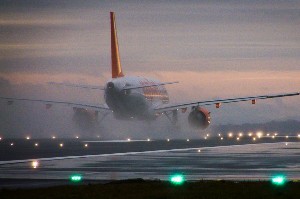 Engineers at Massachusetts Institute of Technology have built a mathematical model that identifies the U.S. airports most likely to influence the spread of disease early in an epidemic. The findings of the team from MIT’s civil and environmental engineering department are found in the online journal PLoS One.
Engineers at Massachusetts Institute of Technology have built a mathematical model that identifies the U.S. airports most likely to influence the spread of disease early in an epidemic. The findings of the team from MIT’s civil and environmental engineering department are found in the online journal PLoS One.
The use of network models to track and predict contagion patterns is nothing new, but most studies up to now have focused on the final stages of epidemics that track the spread of disease to locations that develop the highest infection rates. The MIT model, on the other hand, examines traffic patterns in the first few days of an epidemic, which the researchers believe will be useful to public health officials making resource decisions on combating the spread of disease.
The team, led by energy studies professor Ruben Juanes, investigated the role of the 40 largest U.S. airports in influencing the spread of a contagious disease originating in their home cities. The model was based on Juanes’s research on the flow of fluids through fracture networks in rocks, supplemented with studies by colleague Marta González, who uses cellphone data to model human mobility patterns and trace contagion processes in social networks.
While earlier models assumed random and homogenous movements through the network, the MIT team took a different approach, namely that individual travelers do not travel randomly, but in observable and replicable patterns. The researchers used Monte Carlo simulations, statistical techniques that calculate the probabilities of individual outcomes, in this case the likelihood of any single traveler flying from one airport to another.
The model shows that larger and international airports were the traffic hubs most likely to influence the spread of an epidemic, but some smaller airports also figured prominently. The model ranked New York’s JFK airport first, followed by Los Angeles, Honolulu, San Francisco, Newark, Chicago-O’Hare, Washington-Dulles, and Atlanta.
Honolulu, which ranked third in influence, has only 30 percent of the traffic of JFK, but plays a key role in Pacific air routes because of its central location and many connections to distant, large, and well-connected hubs. Atlanta’s Hartsfield airport, on the other hand, has the largest number of flights, but ranked eighth in spreading epidemics.
Juanes believes the model can help public health authorities contain epidemics early in their contagion. “The findings could form the basis for an initial evaluation of vaccine allocation strategies in the event of an outbreak,” says Juanes, “and could inform national security agencies of the most vulnerable pathways for biological attacks in a densely connected world.”
The following video tells more about the research.
- Universal Vaccines Assessed for Widespread Flu Prevention
- Combating Flu Epidemics Likely to Take More Than Vaccines
- Unregulated Drug Market Hurting TB Public Health Efforts
- Bird-Flu Stopping Transgenic Chickens Produced
Photo: ChronowerX_GT/Flickr
* * *

 RSS - Posts
RSS - Posts
You must be logged in to post a comment.